Hydrodynastes gigas are cobras in name only.
These are false water cobras—but they’re not actually cobras.”
This is a refrain I find myself saying whenever I am introducing people to my snakes for the first time. False water cobras are large, opistoglyphous (rear-fanged) New World colubrids that are, in name only, related to the smaller, aglyphous (fixed-fanged) and highly venomous elapid, the water cobra (Naja annulata).
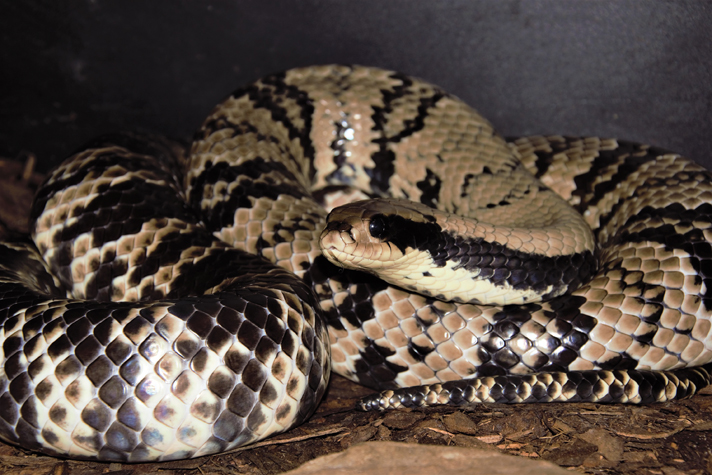
Zachary Loughman
The false water cobra is a large snake; adult females may attain 8 feet in length and weigh up to 10 pounds or more.
Also known as the Brazilian smooth snake due to its smooth, keel-less scales, and on various internet forums and Facebook groups as “falsies” or “FWCs,” Hydrodynastes gigas lives up to its specific epithet gigas, which translates from Latin to English as “giant.” False water cobras are among the largest New World colubrids, and really are only rivaled in size by the various Drymarchon (indigo and cribo) species among colubrids in the New World. While the latter are longer than FWCs, false water cobras have similar weights, with both males and females often reaching a brutish 10 pounds or more.
Natural History, Phases and Genus of Hydrodynastes gigas
Three species compose the genus Hydrodynastes, all of which occur throughout northern and central South America east of the Andes Mountains. The focus of this article, and without question the most common species in herpetoculture, is H. gigas, which has the widest distribution of the three and occurs throughout much of Brazil, northern Argentina, Bolivia, northern Argentina and portions of Peru. Falsies are ecological generalists, and though they don’t require water, are most frequently encountered in wetlands and along streams. Within these environs FWCs feed pretty much on anything they can overpower, though a preference for amphibians, fish and other small vertebrates has been documented.
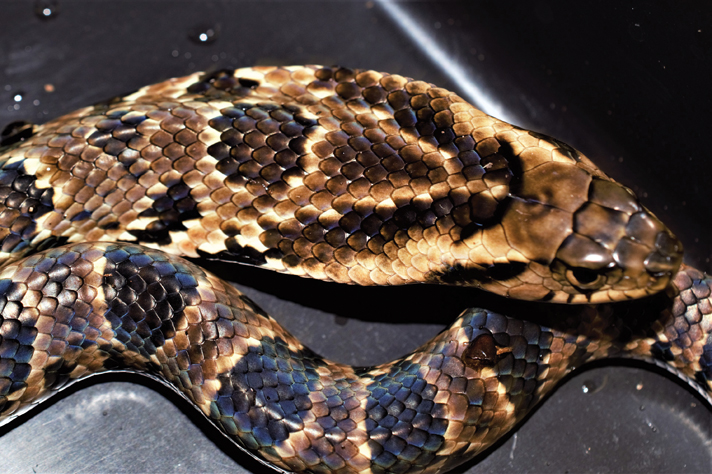
ZACHARY LOUGHMAN
False water cobras such as this neonate do have hoods; similar to true cobras, they’re nowhere near as impressive.
As alluded to previously, false water cobras are large snakes. Sexual dimorphism exists in the species, with females normally reaching longer lengths and heavier weights than males. Adult females frequently reach lengths in excess of 7 feet, though 8 feet seems to be the maximum length for most individuals. Males also can reach these lengths in extreme cases. Sexual dimorphism is most noticeable regarding the snake’s bulk. Females are heavier than males, which when in good health and not obese appear leaner than adult females. Female FWCs that weigh in excess of 10 pounds are not uncommon.
Most false water cobras exhibit some hue of yellow, brown or black, with black bands and squares running the length of their bodies. The head is usually patterned in solid colors, and always possesses an emblematic black eye stripe. Falsies that lack proficient amounts of brown and black and are dominated in light yellows, oranges and light browns are referred to as “hypos” within herpetoculture. There is considerable debate as to whether there is a genetic link to this trait, and the verdict is currently still out. “Lavender” false water cobras lack yellows, browns and blacks, and appear gray, pink and light purple in color. Currently these animals are rare in North America, though they are available in Europe. Silver, golden, and dark FWC lines also occur. The morph craze has yet to hit these snakes, however, and most keepers are quite happy with the natural phenotype.
Two other Hydrodynastes species occur in South America in addition to the false water cobra. In 2007, H. melanogigas, the black false water cobra, was described from central Brazil. It has the same physical stature as H. gigas while being dominated by blacks and grays. At present, this species appears to be a narrow endemic and is of conservation concern.
Arguably both the most attractive and aquatic member of the genus is H. bicinctus, also known as Hermann’s water snake or the double-banded false water cobra. Hermann’s water snakes are rarely found outside of water; what little is known of their biology indicates that they are amphibian and fish specialists that have a more northerly distribution than the previous two species. They haunt marshes, wetlands and rivers in northern Colombia east to Venezuela and south to northern Brazil. The few attempts to keep this species under human care indicate that its specialized diet and need for an aquatic existence makes it a challenging charge to maintain.
False Water Cobra Species Profile
False water cobras have “hoods,” the reason behind their common name, which are produced when the snakes flare out lateral appendages on their neck vertebrae. A benefit of their hooding behavior is that you know when a FWC is peeved or uncertain of its surroundings; quit whatever you’re doing that might be causing this response, and all will be well.
In large specimens, the hood can be 4 to 8 inches wide and a bit intimidating, though the hood of a false water cobra can never equate the impressive display of a true cobra. Most long-term captive falsies lose this behavior. Neonates, on the other hand, are more than happy to hood up, and they are the best demographic in which to witness hooding behavior.
Are False Water Cobras Venomous?
False water cobras differ markedly in the way they deliver biological compounds into their prey compared to elapids, vipers and burrowing asps. The latter all possess fangs that are either fixed or movable in the front of their mouths with canals connected to venom ducts, which are connected to venom glands. This venom delivery system is “pressurized,” and when used, venom freely flows from the venom gland through the venom ducts to the fangs and into the prey. False water cobras possess large, grooved teeth along the posterior portion of their maxillary bones. Duvernoy’s glands, which differ anatomically from venom glands, sit above or in the vicinity of these grooves and rely on chewing motions to release their secretions. Given this venom delivery system is not pressurized, it is referred to as a low-pressure system. This means that prey need to be chewed on in order to be injected with Duvernoy’s gland secretions. The western hognose (Heterodon nasicus), giant Madagascar hognose (Leioheterodon madagascariensis), mussurana (Clelia spp.) and the various species of Boiga all utilize this system, as well.
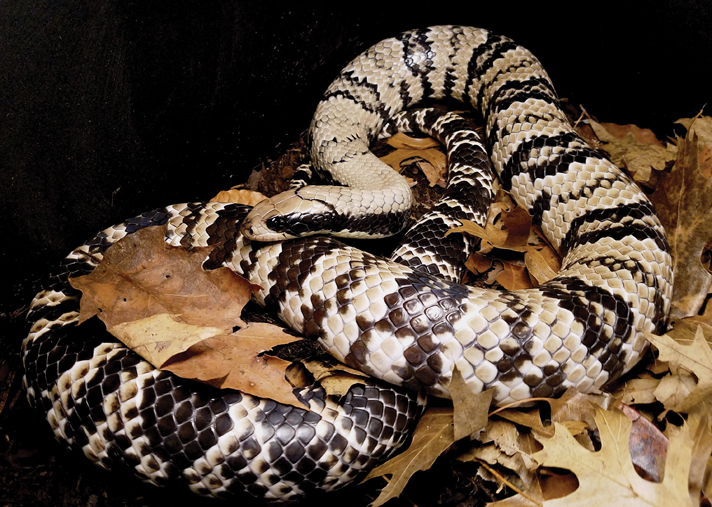
Zachary Loughman
This is a “silver” FWC that belongs to the author.
Many sources compare the potency of the false water cobra’s secretions to the venom of the timber rattlesnake (Crotalus horridus). The reality, however, is that timber rattlesnake venom is far more dangerous than the Duvernoy’s secretions of the false water cobra. This being said, however, FWCs do produce peptides and other biomolecules that can and have caused reactions in humans. To date, no deaths are attributed to false water cobra bites, and most people who are bitten do not experience negative reactions as long as they don’t allow the snakes to chew on them. Everybody is different, however, so until you receive a bite, which I do not recommend, you won’t know where you fall on this spectrum. Because of this, it is best to always treat FWCs with the utmost respect, and interact with them the way you would any venomous snake.
Interestingly, the most violent reactions to false water cobra bites have occurred in people who had the snakes as long-term captives and acquired hypersensitivity to the snake’s Duvernoy’s gland secretions through persistent exposure via their captives.
In addition to a biological reaction, significant mechanical damage can also occur from an adult false water cobra’s bite due to the species’ enlarged posterior maxillary teeth.
Husbandry for False Water Cobras
Given false water cobras start off as foot-long babies and have the capacity to grow into 8-foot brutes, FWC keepers need to accept that their snakes will need multiple enclosures over their life time. A good rule to follow in purchasing an enclosure is to ensure the total length of the reptile terrarium at least equal to the total length of the snake.
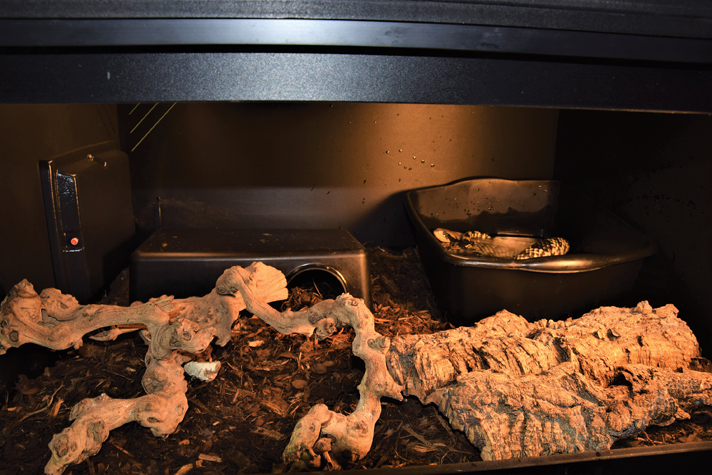
Zachary Loughman
This is one of the author’s false water cobra setups.
Neonates can be housed in 10 to 15-gallon terrarium with a secure lid with accessories and/or front doors. Even when small, false water cobras are incredibly strong snakes and more than capable of popping off lids and escaping. Subadults and juveniles can be maintained in 40-gallon breeder tanks as well as large PVC enclosures. Full-grown adults are best maintained in enclosures that are at least 5 feet long by 2½ feet wide.
All of my false water cobras are maintained in Animal Plastics T-25 enclosures, which are 72 inches long, 30 inches deep and 18 inches tall. When they were growing juveniles I had enclosure dividers in place that effectively reduced the length of each enclosure to 36 inches. Under these conditions my animals thrive, and over the course of the day, each cruises the entire enclosure, warranting the large amount of space provided to them. Because of the aforementioned activity levels, false water cobras do best in vivariums and are really not suitable for tub life. Can you care for a FWC in a tub? Yes. Will it thrive and live the best life it could live? No.
Because of its need for standing water, coupled with a fast metabolism, a false water cobra is messy and has the capacity to produce feces that could stink you out of house and home. Therefore, reptile substrate choice truly matters when keeping this snake. It is important to ensure the substrate you use has a certain level of absorption ability to handle frequent water spills and, more importantly, their frequency of defecation. Cypress mulch, orchid bark and other substrates that can handle high moisture rates are suitable for false water cobra enclosures. Many people consider aspen an effective substrate for FWCs, but in my experience aspen is a not as absorbent as orchid bark and cypress mulch, and because of this I recommend those for use with FWCs over aspen. You can use reptile hygrometers to measure the humidity of your captive habitat.
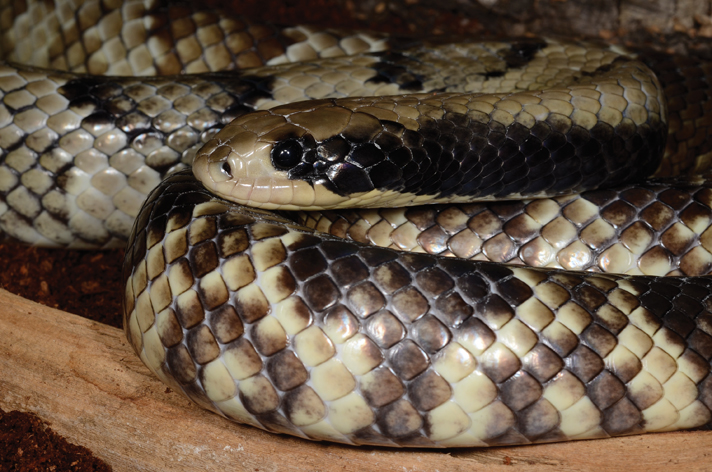
Zachary Loughman
A substrate with strong absorption properties is recommended.
I employ a modified bioactive substrate with minced cypress mulch as the primary reptile bedding. To that I add a small amount of sand and organic topsoil, as well as leaves to introduce beneficial bacteria and fungi to the substrate. I also add about 25 superworms to the substrate. Superworms feed on the feces, which is also absorbed effectively by the mulch and soil, reducing the total mess. Urates and other wastes are rendered inert by the fungi and bacteria, effectively controlling the odor and waste potential of the snakes.
I replace all of the substrate in each enclosure once every four months, and spot clean each enclosure daily, which is a must if you own a false water cobra. All good FWC enclosures provide both a hide (like the Zoo Med Habba Hut) and water source large enough for the snake to fit its entire body into, like a large ceramic water bowl. For hides, I use XL reptile hides available online as well as cork bark flats and tubes. I also provide each snake with multiple small tree and grapewood branches, as well as small stumps I collect from the woods that I bake for an hour at 400 degrees Fahrenheit to kill any parasites. You can get creative when it comes to the reptile accessories with this species. A variety of snake habitat products are available in pet shops and online. Live plants are an option for neonate FWC enclosures, but given the large size of adults, most plants will be quickly pulverized by these large, active snakes.
Most FWC keepers, myself included, maintain a thermogradient with the hot side of the vivarium maintained around 88 degrees and the cool side around 75 degrees. When given the choice, all of my animals choose cooler over warmer temperatures. This can be measured with reptile thermometers and controllers like the Zilla Habitat Heat Controller.
When it comes to reptile heating and lighting, I provide heat one of two ways. I use basking lamps and ceramic heaters (like the Zoo Med Ceramic Bulb)—falsies will readily bask if provided a basking light, and they seem to seek out UVB light when it is available—and for enclosures where basking lamps cannot be provided I use RBI radiant heat panels that are connected to thermostats, and provide light via LEDs. Under-tank heaters like the Zilla Heat Mat can also be used. Use appropriate reptile fixtures for lighting.
If you are using an under-tank heater or radiant heat panels be sure these instruments are connected to a thermostat. All my lighting is connected to reptile timers to maintain a 12-hour-on, 12-hour-off daily light schedule.
False Water Cobra Behavior
One of the most rewarding aspects of keeping false water cobras is interacting with these incredibly intelligent, responsive snakes. Adult FWC behaviors are somewhat different than that of juveniles and neonates, though.
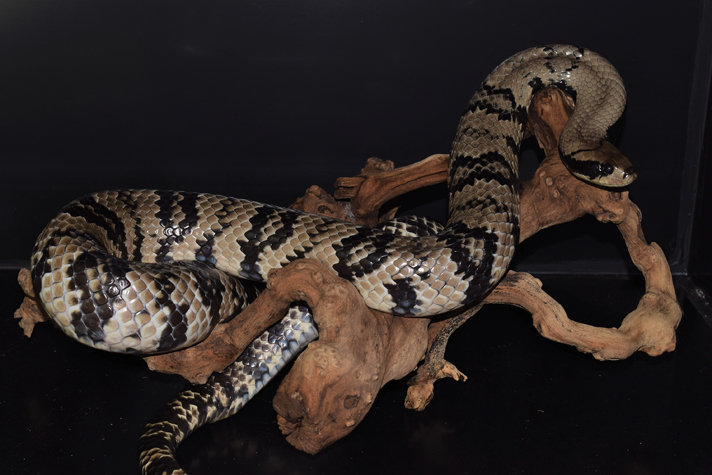
Zachary Loughman
The false water cobra makes a unique and engaging pet.
When they are small, FWCs bite more frequently. This is understandable, because in their wetland natural habitat they are food for pretty much every carnivorous mammal, bird and reptile they encounter. All of my falsies went through a stage as babies when they would either strike outright, or spread their iconic hoods and put on quite a little threat display. As FWCs mature they become more confident and more acclimated to their keepers, and tend to lose their likelihood to bite as well.
Falsies are inquisitive snakes that are always aware of their surroundings. My adults often sit with the front third of their bodies outside of their hide boxes, head slightly elevated, and actively watch what is happening outside of their enclosures.
Whenever I am interacting with them and they don’t want to be bothered, my snakes exhibit a behavior I have not experienced before with any other snake: they thump or tail whip using the rear third of their bodies! If they have the right angle, they actually can acquire enough velocity for this to sting just a bit. In my experience, though, most adult false water cobras are easily handled, though this should not be done without at least a hook, given the possibility of a bite is always there, as well as the chance you might react to said bite.
False water cobras, as their name may indicate, are also infamous for soaking in water basins. There is a bit of debate among FWC keepers as to why the snakes soak. Mine tend to do so especially if their enclosure temperatures get too high; they will begin to soak, trying to thermoregulate their excess heat away. This being said, two of my animals frequently soak regardless of the temperature in their enclosure.
Reptile Food for the False Water Cobra
False water cobras are infamous for their intense response to food. On more than one occasion I’ve slid open an enclosure’s glass front and been met by an open mouth firing out of a hide box lunging toward my hand. When she was a juvenile, one of my females would bury herself in the substrate with only her head exposed. As soon as a prey item was presented within six inches of her head, she would immediately erupt her entire body in the direction of the prey and start biting at everything until she made contact with her mouse or rat pup.
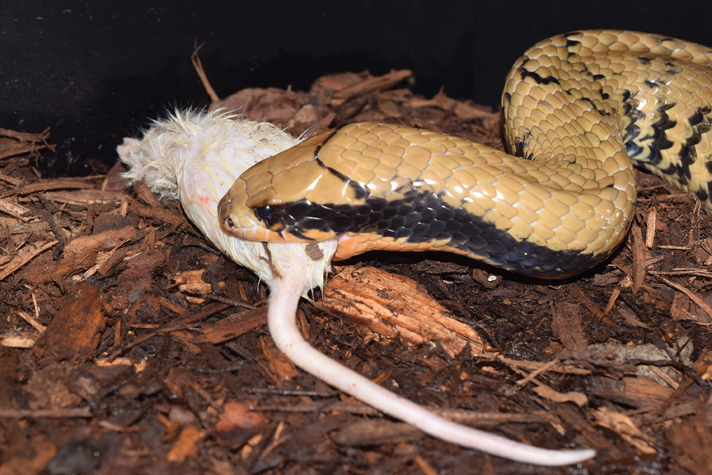
zachary loughman
Be sure to feed your snakes a sufficient amount of food. Falsies are often underfed, which can lead to stunting.
What’s even more startling is what happens after a false water cobra makes contact with its prey. These animals constrict, body slam, pin and, if the prey item is small enough, simply engulf their prey. They are arguably among the most dramatic and impressive colubrids when it comes to exhibiting a feeding response, and because of this it is best to feed false water cobras with tongs to avoid receiving an accidental bite while feeding.
With all this being said, I do have a male that has never displayed a strong response to food; he’s actually somewhat shy when it comes to feeding. One of the best aspects of keeping these snakes is figuring out their individual personalities, which is easily done when the dinner bell rings.
Given their generalist ecology, false water cobras eat myriad vertebrates, which makes feeding them somewhat straightforward. Mice, rats, chicks, fish (including trout and tilapia filets) and frog legs are all foods FWCs will consume.
Over the course of a snake’s life, diet preferences may shift. Most FWCs readily except large pinkies or even fuzzy mice as their first meals. Finicky neonates will normally feed on goldfish and rosy reds, though be wary about making these a young FWC’s staple diet due to thiaminase issues. Scenting pinky or fuzzy mice with goldfish or frogs should induce a feeding response in stubborn neonates.
A good rule of thumb in choosing prey items for your false water cobra is to offer those that are at least equal in width to the width of your snake’s head. Once a FWC reaches 20 inches in length it can begin feeding on weaned rats, and rats should remain the staple of the snake’s diet from that point on.
Because they have a fast metabolism, false water cobras should be fed more often than most colubrids. I feed my adults small to medium-sized adult rats every Monday and Thursday. The results of their fast metabolism and willingness to eat is growth, a lot of growth. Many FWC keepers are shocked when their foot-long baby snake reaches 5 to 6 feet in length after its first year of life! I experienced this with one of my females. When I purchased her, she was 17 inches long and weighed 53 grams. Exactly one year to the date that she entered my collection, employing the previously described feeding schedule, she weighed 4.6 pounds and was 5 feet in length! Currently, she is still growing, and will likely max out between 7 and 8 feet sometime during the next year.
It is incredibly important that anybody reading this article take this into consideration prior to purchasing a false water cobra. These snakes are often underfed, and the result is stunting. I have a male that was 2½ years old when I purchased him and only 4 feet in length. After a year in my care he reached 5½ feet, but he’ll never reach his full size potential.
False Water Cobra Breeding Tips
Naturally, the first step in any breeding project is to ensure you have a male and female snake. Like most snakes, false water cobras should be probed as adults to ensure this is the case. As babies and juveniles, they display a unique sexual dimorphism in the coloration of the ventral surface of their tails. Males tend to have all black to black-dominated subcaudal scales, while females display brindled or mottled brown, yellow and black subcaudal scales. Unfortunately, sexing with this method doesn’t work 100 percent of the time, but it does occur with enough frequency for it to be used as a backup to help verify probing results.
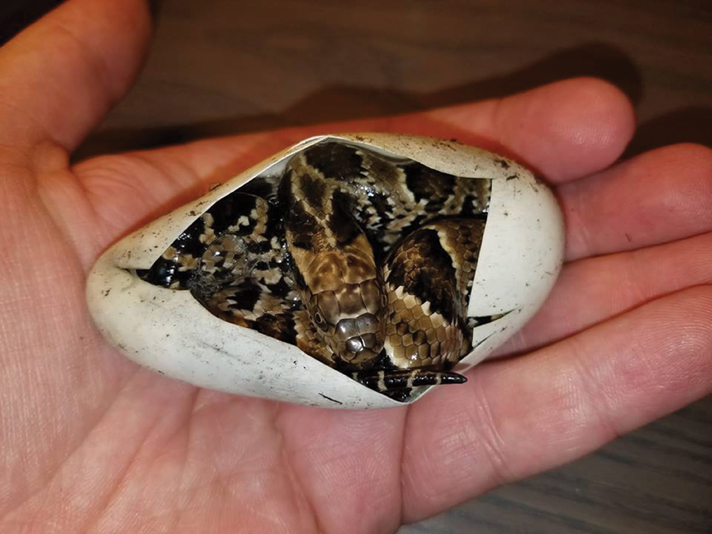
ZACHARY LOUGHMAN
One of the author’s baby false water cobras still inside its egg.
Female falsies should not be bred until they are at least 3 years old, if not older, and breeding attempts should not occur with a female less than 6 feet in length, to ensure she has the correct body condition to maintain developing eggs.
To cycle or not to cycle? That is the question when it comes to FWC breeding. Most breeders do not cycle these snakes prior to mating attempts, while others do. There doesn’t appear to be a need for cycling, though the process may prove important to the long-term health of females. The climate of their South American homes does experience some seasonality, which is why I drop the temperature of females roughly to room temperature for two months in the early fall prior to initiating breeding.
Males should be introduced to female enclosures and watched, especially if the male is smaller than the female. Falsies are notorious cannibals, and if you don’t watch your charges there is a good chance one of them may be eaten by the other. Falsie breeding is amorous and aggressive, with males chasing females until copulation ensues. Males often will bite the necks of their mates, which is normal. Locks last anywhere from 10 minutes to 12 hours. To ensure successful matings, I introduce the male for 12 hours, take him out of the female’s enclosure to reduce stress for a day, and then reintroduce him. That’s normally all it takes. Females will begin to swell, and when fully gravid look enormous! False water cobras can be fecund and lay more than 30 eggs, though most clutches contain between 15 and 25 eggs.
Provide a lay box containing moist sphagnum moss, as well as sphagnum moss in the corners of the enclosure after the female’s pre-laying shed. False water cobra eggs are huge compared to other colubrids, so make sure you have an incubator that’s big enough to handle the clutch. I incubate eggs between 80 and 85 degrees, trying to keep my incubators at 83 degrees for the two to two-and-a-half-month incubation period.
Falsies are slow to hatch, so don’t be surprised if your neonates pip and then spend the next day or two inside their eggs before they emerge. Once they have emerged, I transfer mine to individual plastic shoeboxes in a neonate rack (the only time my FWCs live in a tub). After two months of growth, what was a 12 to 14-inch hatchling will be a 20 to 25-inch baby, which I then transfer to 20-gallon-long grow-out enclosures.
Given the false water cobra’s opistoglyphous condition, it is best that only people with considerable snake-keeping experience keep this impressive snake, and because of a recent surge in captive breeding, there is absolutely no need for anyone to purchase wild-caught falsies that seldom thrive in captivity.
All in all, it’s the snake’s engaging intelligence, impressive size and need for a large, display vivarium that, in my opinion, places the false water cobra among the most rewarding and engaging snakes a person can own.
Zachary J. Loughman, Ph.D., has kept reptiles and amphibians as a hobbyist and professional for more than 20 years. He is an associate professor of biology at West Liberty University, and coordinator of the University’s Zoo Science and Applied Conservation, which prepares students to work in zoos and aquariums or as conservation professionals. Zac also is internationally known for his research on freshwater crayfish, which has resulted in more than 35 peer-reviewed articles as well as the description of 10 new species.


